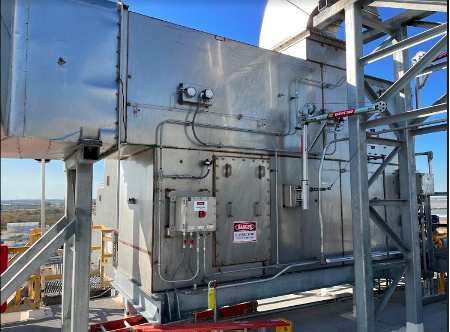Pros and Cons of Indirect and Direct Air Heating
- Posted on 6th May 2022
- in Direct Heating, Dryers, Indirect Heating, Spray Dryer
- by Melissa Hickman
GLM Luebbers utilizes spray dryers in a wide variety of applications. Spray dryers generally use hot air to evaporate moisture out of atomized product droplets, so the droplets eventually become powder. The methods for heating the process air vary widely, with advantages and disadvantages to each approach. Understanding these differences and how they affect the process is critical to choosing the right type of heat exchanger for the intended purpose.
Indirect air heating uses thermally conductive heating components; there is a separation between the product and the air heating it. Some examples of indirect heaters include tubular or plate heat exchangers to transfer energy from gasses heated through combustion to the process air. Other forms use electric or steam energy. Direct air heating is different from indirect heating because the air is heated by passing through and around combustion flames.
![Figure 1: Diagrams of indirect (left) and direct (right) air heating systems [5].](https://www.glmluebbers.com/wp-content/uploads/2022/05/Diagrams-of-indirect-left-and-direct-right-air-heating-systems.png)
Figure 1: Diagrams of indirect (left) and direct (right) air heating systems [5].
Indirect heat exchangers must transfer energy through an intermediate substrate, such as steel, which reduces the thermal efficiency. However, air that heats the process gas in indirect heaters can be recirculated because it is not in direct contact with combustion byproducts, such as nitrous oxides. Additionally, the heated air does not need to be fully reheated for each circulation through the system [1]. Furthermore, energy can be reduced, and cost can be minimized because there is no need to heat more air.
For direct heat transfer systems, maintenance is reduced and simplified, as they are less complex than indirect systems. Due to their simplicity, direct systems are more affordable and easily repaired, replaced, and relocated, reducing downtime in the plant if any issues were to arise [3].
Temperature and humidity control:
With indirect heaters, moisture is not added to the air, which enables the process gas to keep a constant humidity ratio in the heating process [4]. In applications where it’s important to control the exact temperature of the product, this can cause challenges. In milk products, for example, heating at too high a temperature creates a high risk of denaturing the proteins of the product, potentially reducing quality.
Direct heaters are better suited for controlling exact temperatures than indirect heaters [3]. The use of direct heaters results in the addition of moisture to the process gas, as combustion adds moisture to the air.
Customizable to fit needs:
Indirect heaters can be extraordinarily large, as shown in Figure 2, as a result of the heat transfer surfaces required. Direct heaters are usually customizable to suit the job’s needs. They typically are smaller than an indirect equivalent. This is very beneficial, especially if the heat exchanger must fit around any previously placed machinery [3].

Figure 2: Indirect air heater operating at 6 MM Btus, installed by GLM Group in Texas.
Sanitation and operation:
Indirect heaters allow for the separation of the product and combustion gasses, so there is no contamination of the product [1] from the byproducts of combustion.
Both direct and indirect heat exchangers have safety features that allow for minimal supervision when the heater is in operation. This maximizes operator safety, as well as minimizing the cost of labor. However, indirect heaters eliminate the possibility of powder coming in contact with a flame which significantly reduces the chance of an explosion.
There are many benefits to both indirect and direct heat exchangers. Both options should undergo careful consideration before deciding which technology is best for the intended operation. GLM can consider these and other aspects to find the best solution for your new or existing system.
Contact us for more information when you are considering installing a direct or indirect air dryer system or for any of your other spray dryer or evaporator needs.
Resources
[2] https://en.wikipedia.org/wiki/Heat_exchanger
[3] https://preferredclimatesolutions.com/the-difference-between-direct-and-indirect-fired-heaters/
[4] https://kw-engineering.com/benefits-disadvantages-indirect-direct-evaporative-cooling-idec-systems/
[5] https://www.hydro-thermal.com/how-it-works/heat-exchanger-vs-direct-steam-injection
- Pros and Cons of Indirect and Direct Air Heating - May 6, 2022
Tags: Direct Air Drying, Direct Dryer, Dryer, Heat Exchanger, Indirect Air Drying, Indirect Dryer, Powder production, Spray Dryer
